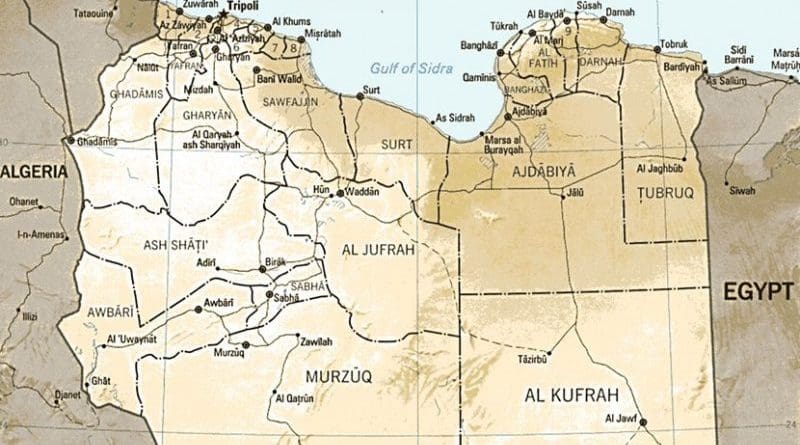Before Our Eyes, Libya Descends Into Chaos – OpEd
By Arab News
By Talmiz Ahmad*
The day after two bomb blasts killed 40 people in Benghazi, Libya, last month, local military commander Mahmoud Al-Werfalli, already wanted for war crimes by the European Union, publicly executed 12 people in his custody. Five more bodies were discovered the day after, with notices attached to them stating they were extremists.
The military arrested more “terrorists” as slogans supporting the bombings appeared on city walls.
With Libya wracked by widespread conflicts after the fall of Muammar Qaddafi in 2011, the UN had attempted national reconciliation with the Libyan Political Agreement (LPA) in December 2015 that put in place a Presidential Council in Tripoli with executive powers and the House of Representatives (HOR) in Tobruk as the legislative body.
However, this effort at national unity has not worked, with the two power centers functioning independently, backed by well-armed militia with ethnic, tribal and religious affiliations.
This brew of internecine conflict has grown more complicated with the military prowess and political ambitions of a soldier from the Qaddafi era, General Khalifa Haftar. An associate of Qaddafi from the revolution of 1969, he fell out with his leader in the 1980s and took refuge in the US. Twenty years later, in May 2014, he launched Operation Dignity to cleanse the country of terrorists, encompassing all militant groups — the Muslim Brotherhood, Al-Qaeda and later Daesh.
The Libyan National Army (LNA) headed by him now controls much of eastern Libya, including the oil-producing facilities of Ras Lanuf, Al-Sidra, Zawaytania and Brega in the Libyan oil crescent on the Mediterranean coast. Haftar is nominally under the Tobruk-based HOR but appears to be a largely independent political player in national affairs.
The government in Tripoli, headed by Fayez Al-Sarraj, gets its military support from militia groups in Tripoli and Misrata, the latter having some of the most powerful militias in the country.
Militant veterans of the Afghan war first came to Libya in the late 1980s, and, after Qaddafi’s removal, set up Ansar Al-Sharia Libya (ASL). While linked with several assassinations, including the killing of US diplomats in Benghazi in 2012, they also sought popular support with the provision of local services, health care and religious teaching. In May 2017, under attack from Haftar’s forces, the ASL quietly disbanded itself, with its members merging with local populations and waiting to fight another day.
Daesh fighters from Syria first established themselves in the eastern town of Derna in 2014. A coalition of Misrata-based forces evicted Daesh from Derna in 2015 and Sirte in 2016. They are now dispersed — westward to Sabratha, southwest to Sabha, and southeast to the Sudan border.
What is of global concern is that Daesh, centred at Sabratha, is at the heart of numerous militant attacks in the region and in Europe, including those in Paris, Brussels, Manchester, Germany and Italy. Aaron Zeilin has noted that “Libya now stands as the fourth-largest foreign fighter mobilization in global jihadist history, behind only the current war in Syria, the Afghan jihad of the 1980s, and the 2003 Iraq war.”
With the defeat of Daesh’s proto-state, the movement can be expected to rely increasingly on “lone-wolf” operations, with Libya at the heart of such threats.
The breakdown of state order in Libya and the proliferation of militia controlling different regions has meant that large tracts of the country and coastline are without effective security forces or are controlled by militia that are part of region-wide trafficking networks dealing with human beings, drugs, food, petrol, and weapons.
With 150,000 migrants having crossed through Libya to Europe in the past three years, Libya is now seen as Europe’s “true southern frontier,” amid horrendous reports of African migrants stuck in Libya also being sold as slaves by traffickers.
In this fraught situation, the UN has called for national elections in late 2018, describing them as the “peaceful and inclusive end to the transition phase.” It is encouraging that about two million Libyans have already registered to vote.
Nevertheless, serious problems remain. It is not clear how enthusiastic strongman Haftar is about the process. In a recent interview, he suggested that Libya might not be ready for democracy and reminded his interlocutors that he controls half the country and has an army of 75,000. Many observers believe he is poised to seize power by taking Tripoli with military force. But given the large number of strong militia in different regions that might form a coalition against him, such a coup attempt might not be successful.
The gravest problem remains the absence of governance and the continued inability of local authorities or regional militia to provide security, employment and civic services.
This has increased the numbers of those whom commentator Rebecca Murray has described as “militarised, unemployed and marginalised youths” who will swell the ranks of militants and extremist groups.
Libya can be expected to remain mired in fratricidal conflict for some time to come.
*Talmiz Ahmad is a former diplomat and holds the Ram Sathe Chair for International Studies, Symbiosis International University, Pune.

